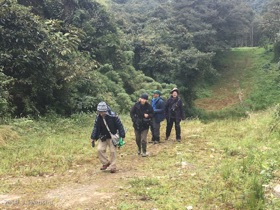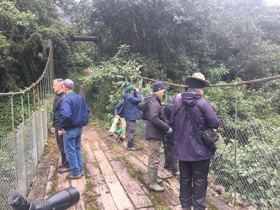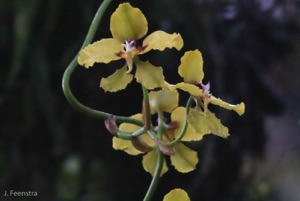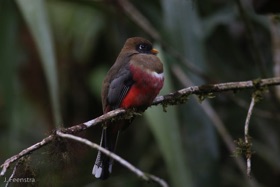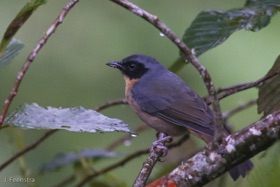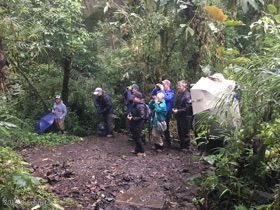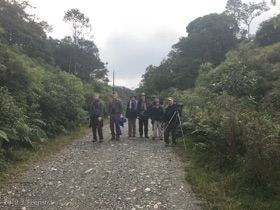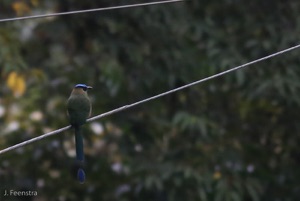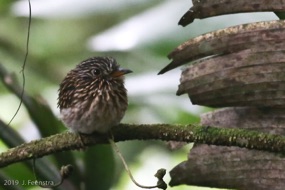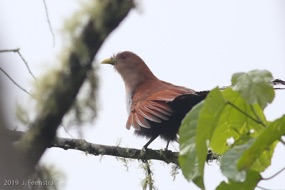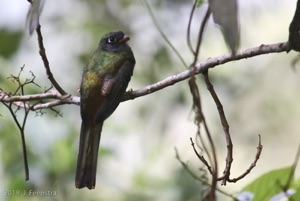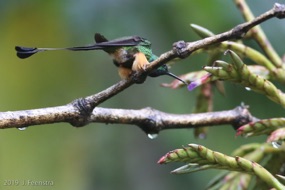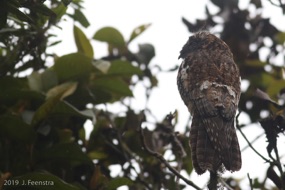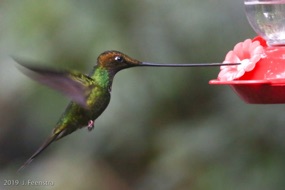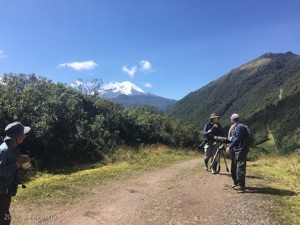This narrative is adapted from the account I wrote for the WINGS website HERE, but this one has photos!
The gang: Lilian, Steve, Frances, Phil, Doug, Don, Graham, Jon (bird guy), Edwin (el conductor)
Eastern Ecuador is the Amazon, but The Amazon isn’t only that lowland rainforest; the biological influence of that great jungly basin extends its watershed fingers up into the foothills and high onto the east slope of the Andes. The forest is thick and rich in bird life. All that and good roads, lodges, and birding tourist infrastructure make for a great place to tour. And so we did! We traveled through about 3000 meters of elevation change in six days, saw nearly 300 species including 37 hummingbird species, and found some of the Andes and Amazon foothills’ most iconic species like Gould’s Jewelfront, Golden-collared Toucanet, Crested Quetzal, White-chested Puffbird, Andean Potoo, and Peruvian Warbling-Antbird.
Our first morning out taught us a lesson in humilty before the might of nature. We birded the high pass heading east from Quito. Approaching 4500m elevation, the air is thin, and the weather is
temperamental. It started cold and damp, and everyone was wearing all of their clothes. We got nice looks at Chestnut-winged and Stout-billed Cinclodes, Andean Tit-Spinetail, and a cooperative Tawny Antpitta singing from the top of a dry plant stalk. Then we tried for Rufous-bellied Seedsnipe at the very top of the road. The wind was howling, blowing the fog around, and the visibility was almost nothing. The mountain won. We heard the seedsnipe somewhere out there, but that one was going to get away. We went downhill, enjoyed a hot lunch at Guango Lodge, and checked out some hummingbirds including a couple of outrageous Sword-billed Hummingbirds. We descended a little more and birded some forest patches below the town of Baeza.
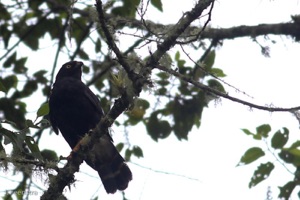
The highlight there was a very cooperative White-rumped Hawk that emerged from the forest in front our driver while he was waiting with the van. He called us back and we had extended looks as this striking small hawk jumped around and made short flights above us. Following that we made it to Cabanas San Isidro, our base for the next two nights. After dinner we wandered out and got nice looks at the “San Isidro” Owl and we even found a kinkajou rampaging around in the canopy of a tree over the driveway.
We didn’t have to go far on our next day. We started right on the back porch of the dining room watching birds come in to eat moths that had collected at the lights all night. It was quite the show as Montane Woodcreepers, Black-billed Peppershrikes, a pack of rambunctious Green Jays, and a bright Canada Warbler, among others, worked the place over. After a bit of that we were led into the forest to watch the White-bellied Antpitta get fed. It had apparently not showed the day before, but this morning there were two waiting for the lodge employee to show up with the earthworms.
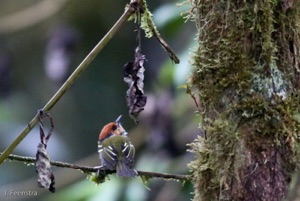
Then we spent the rest of the day with the forest flocks, working the roads that lead through the beautiful cloud forest reserve. Among those flocks were several small groups of showy Blue-winged Mountain-Tanagers, Bery-spangled Tanagers, Flame-faced Tanagers, and Saffron-crowned Tanagers. We also had great looks at a few Green-and-black Fruiteaters perched stolidly in the canopy. Below in the bamboo thickets we saw a couple of diminutive, bright Rufous-crowned Tody-Flycatchers and the unexpectedly colorful Streak-headed Antbird, all before another superb dinner.
Our second day from San Isidro was a “What a day!” sort of day. We covered a huge swath of elevation from the cooler cloud forest around the lodge all the way out to the foothill rainforest at our next lodge, Wildsumaco. The birds today were equally diverse. In the cloud forest we did very well with “big green things.” We saw a family of Andean Motmots, including one inspecting things from the prominence of the power lines. A little further along we had both Crested and Golden-headed Quetzals swooping around grabbing fruit, their electric green backs standing out, but also somehow blending into the forest.
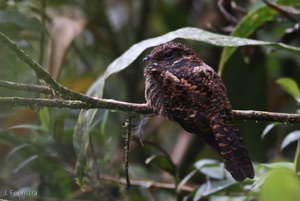
We had a five-star lunch then left Cabanas San Isidro for lower elevations, but made a quick stop along the way near the Guacamayos pass for a roosting Swallow-tailed Nightjar. We made a few stops in the lower country before reaching the lodge. The first was near an old quarry for a trio of Cliff Flycatchers. A little stream ran along the edge and we flushed a Fasciated Tiger-Heron. Another stop at some gardens brought us into the first of our foothill hummingbirds including White-tailed Hillstar, Wire-crested Thorntail, and the very practically named Many-spotted Hummingbird. We stopped again for a few more odds and ends and arrived at Wildsumaco, just as the rain started.
A full day at Wildsumaco was quality and quantity. It started out hot with all sorts of interesting things coming to the moth light including a couple of Peruvian Warbling-Antbirds and White-backed Fire-eyes among other antbirds and a Collared Trogon. We were on foot after that walking the road that passes by the lodge and through different kinds of forest and pasture edge. We had a few dizzying flocks where new birds all appeared at once. There were some tanagers, but it was mostly other things like Rufous-naped Greenlet, Ecuadorian Tyrannulets,
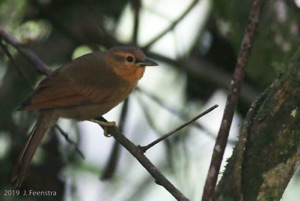
Cerulean Warblers, a Lafresnaye’s Piculet, Bananaquits, and Blue Dacnises. At lunch, just by chance, a pop in at the moth light found us two White-chested Puffbirds sitting inconspicuously on a branch. The hummingbird feeders were equally exciting and we got to see the orange-booted Booted Racket-tails, Napo Sabrewings, and a Gould’s Jewelfront. That was all punctuated nicely by great meals and a comfortable place to hide when the afternoon rains came.
Our next day was a big swoop from the warm foothill rainforest back up into the cold clouds. We started again at the moth light. Though the same birds were about, we got better looks at things, and the White-backed Fire-eyes didn’t scare away the Black-faced Antbird before we all got to see it. We checked out of the lodge after that and spent another couple of hours birding the lower elevations of the access road.
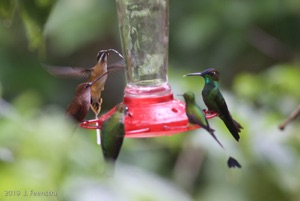
We had a few new things down there including big, showy stuff like a Green-backed Trogon and a Channel-billed Toucan, and little showy stuff like a Swallow Tanager. Then we began our ascent. We ate our picnic lunch at an as-yet-unnamed reserve with some hummingbird feeders. The hummingbird tap was open and hordes of the little monsters were getting their sugar fix. We caught up with Violet-fronted Brilliant (lots of them) as well as a Tawny-bellied Hermit. We arrived at Guango in the mid afternoon. After the distraction of even more hummingbirds, we got word from the lodge staff that an Andean Potoo had been found on a day roost, so we checked that out. It looked like wood, but it was a bird, and a great end to a day of extremes.
The last day was all up in the highlands. We started at Guango lodge on a striking clear morning and went up from there. There are days that hit it the way that perfectly exemplifies birding in the tropical forest, and this was one of them. It was calm and pleasant as we walked some trails, found some multi-colored Gray-breasted Mountain-Toucans had some brief looks at a few tanagers. We were walking back to the lodge when every bird on the property appeared in the trees at once. There were Scarlet-bellied, Hooded, and Lacrimose Mountain-Tanagers, a couple of Blue-and-black and Beryl-spangled Tanagers,
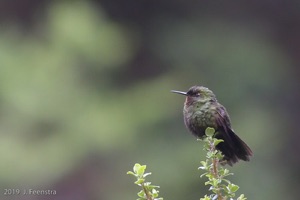
Crimson-mantled Woodpeckers, Black-capped Hemispinguses, and even and Plushcap. And, those were just the highlights, and it was spectacular as everything whirled about in a maelstrom of color. From there we went to treeline and beyond, back into the thin air, but this time with a spectacular view of the Antisana volcano. We got Great Sapphirewings hovering with their giant blue wings over alpine flowers and subtle Black-backed Bush-Tanagers lurking below. Way up at the top a lone Jameson’s Snipe was wandering around the barren heights. Then it was time. We cruised back down the mountain to civilization on the other side. Looking back on the great week full of iridescent hummingbirds, glittering quetzals, sneaky antbirds, and festive toucans it all seemed too short of a time to be around these wonderful things. We saw so much out there in that short time, stayed in great lodges, ate great food, all with great people, and now have a lot to remember.
(Want to see the photos and crowd-sourced identifications of the non-birds? Check out my iNaturalist entries from this tour by clicking HERE.)

